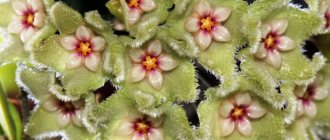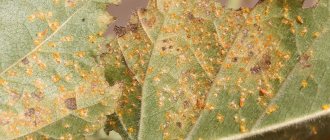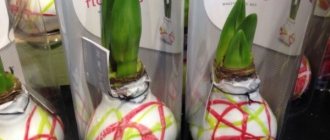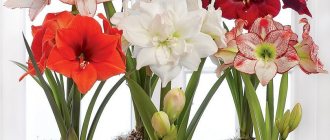Author: Elena N. https://floristics.info/ru/index.php?option=com_contact&view=contact&id=19 Category: Houseplants Published: February 21, 2019Last edits: January 11, 2021
Among the bulbous flowers there are two twins, which are difficult for an inexperienced person to distinguish from each other. The rules for caring for each of them are almost the same, so flower growers are accustomed to calling both hippeastrum and amaryllis amaryllis. But despite the family similarities, these are still different plants. One produces leaves after the formation of inflorescences, the other first grows and develops, and then begins to bloom.
- How to distinguish hippeastrum from amaryllis?
- Which plant has a hollow peduncle and which one has a dense one?
- What is the difference between the structure of the inflorescences of amaryllis and hippeastrum?
We have collected for you interesting facts about the flowering of amaryllis and hippeastrum and bring them to your attention.
Amaryllis. Description of the plant
In the wild, during the short period of flowering of the savannah, the bulbous Amaryllis flower manages to decorate its lush herbs. After 1-2 months, when a drought sets in, it goes into long-term rest, only to be reborn with renewed vigor a year later. At home he behaves exactly the same.
The flower has a double called hippeastrum, with which even experts often confuse it. It is this one that is present on most window sills, as it has been most mastered by breeders who have created many hybrid varieties. Amaryllis was once considered a type of lily; in the 18th century it was identified as a separate species by the Swedish botanist K. Linn.
Amaryllis is a flower whose home care is determined by its growth pattern. An herbaceous perennial with an elongated bulb up to 10-12 cm in size, during the active period it produces a bare, smooth peduncle stem 40-60 cm high. Paired leaves, also emanating directly from the bulb, have the shape of long, narrow knives and are dark green, juicy coloring
An inflorescence of 2-12 large funnel-shaped flowers opens at the top of the stem. In South Africa, this event occurs in the spring and lasts 1-1.5 months, in our country, accordingly, flowering occurs in the fall and ends twice as fast.
Flower growers have learned to shorten or extend the resting time of a plant, encouraging it to bloom by a specific date. But this disrupts the natural course of events and can affect the health of the flower.
Large flowers, growing up to 10-12 cm in diameter, are colored from white and soft pink to purple and lilac in a variety of shades.
Luxurious inflorescence
In nature, in their natural habitats, amaryllis bloom in May, but in our not-too-warm latitudes, the dormant period of amaryllis lasts until the end of spring. At the beginning of summer, new amaryllis bulbs are planted in the ground, and plants planted in pots must be watered and fed before the beginning of summer so that the bulbs form full-fledged flower buds.
- Indoor balsam (impatiens, light)
Amaryllis blooms in August-September. The plant produces a dense, powerful peduncle up to 80 cm high, at the top of which there is an inflorescence of several flowers similar to lilies. Usually there are from 2 to 12 pieces. If there are a lot of flowers, then they are arranged in 2 tiers. The inflorescence itself has an umbrella shape. And the flowers are funnel-shaped, six-petaled, with a diameter of 6 to 10 cm, with an elegant thread-like pistil and 6 stamens.
Amaryllis flowers are most often white, hot pink or light pink. Their wonderful aroma is reminiscent of hyacinths. The flowering period can last up to a month. It depends on how many buds there are in the inflorescence. And there may be more than one arrow. Sometimes amaryllis produces 2 arrows, and this prolongs the flowering period. Flowering also depends on proper care of amaryllis.
The leaves surrounding the amaryllis peduncle are dense and belt-like. There are up to 15 of them, they are located oppositely, reach 3 cm in width, and 50 cm in length.
Distinctive features of Amaryllis and Hippeastrum
“Brother” plants are not complete twins, and therefore when purchasing a bulb or potted flower, you can determine what exactly the consultant is offering.
| Differential factor | Amaryllis | Hippeastrum |
| Place of birth, degree of adaptation to a different climate | South Africa. After the country of “eternal summer”, it is more difficult to get used to other conditions and is capricious in care. | South America. Easier to adapt, less picky. |
| Bulb shape and size | Elongated, elongated, pear-shaped, up to 12 cm | Round, onion-like, 7-9 cm |
| Peduncle stem | Rich green color, up to 60 cm long, dense to the touch when squeezed. | Green with a reddish tint, over 60 cm long, hollow inside. |
| Flowering period | Autumn, blooms once a year | End of winter - beginning of spring, may bloom again at the end of summer (depending on living conditions and variety). |
| Color range of inflorescences | Shades from white to red | Wide palette: shades of red (to dark burgundy), yellow, orange, as well as multi-color options. |
| Number of flowers in inflorescence | 5-7, up to 12 | 2-4 |
| Aroma | Pleasant, bright | Weak or absent at all |
| Number of species | 4 main ones, the rest of the varieties are the result of selection | 80-90 main, more than 2000 selected varieties |
Conditions for keeping the plant at home
Amaryllis is a flower that requires attention and some skills from the gardener to care for at home. The plant has two phases of life: dormancy and vegetation, and therefore the conditions for keeping it during these periods must be different.
Lighting
A flower born in sunny Africa loves bright light during the active period and prefers the south, southwest, southeast side of the house. However, during the hottest period it must be slightly shaded to avoid burns.
To ensure the health of the plant, its daylight hours must last at least 14 hours. And in order for the tall peduncle to grow straight, without bending to the side, risking breaking off under the weight of the inflorescence, the pot should be periodically rotated around its axis.
A plant that has gone into a dormant period and dropped its stem and leaves is put away in a low-light place: in some apartments the pot is placed in a pantry or bathroom, in houses - in the basement.
Temperature
During the growing season, Amaryllis prefers a fairly high and constant ambient temperature (22-250C); a nighttime decrease of approximately 5 degrees is allowed.
On vacation, the room temperature should be between 10 and 13 degrees. These conditions will allow the plant to gain strength for new flowering without stress. However, it should be remembered that a further decrease in temperature will destroy the flower.
Humidity
Regarding air humidity, there is a simple relationship: the higher the air temperature, the more effort should be made to increase the humidity in the room. In hot weather, the flower should not only be watered, but also sprayed regularly.
To create a comfortable environment, you can place an electric humidifier, a vessel with water or an aquarium next to the plant.
Amaryllis, like almost all indoor plants, does not like drafts, but responds well to airing the room.
Soil and drainage
When purchasing land, you should choose soil designed for the bulbous plant family. When creating a substrate yourself, you need to mix equal parts of turf and garden soil, coarse sand, peat and humus.
The pot for Amaryllis should have holes to drain excess water. A drainage layer of up to 4 cm must be placed at the bottom of the container. This can be expanded clay purchased in a store, small pebbles or coarse sand.
Watering
The South African flower needs watering, but does not tolerate excess water. It should be watered during the growing season only when the earthen coma is dry (but not dry). The soil in the pot just needs to be moistened by directing the spout of the watering can around the perimeter of the pot, without getting on the bulb.
Excess water should be poured out of the pan to avoid rotting of the root system. It is even better to water through a tray.
At the end of the active phase, when flowers and leaves wither, the amount of watering is reduced to twice a week. During the dormant period, the flower is not watered at all or, if necessary, this is done during inspection once every 2 months. Regular watering is resumed in the summer, when the bulb shoot reaches approximately 10 cm.
Amaryllis at home care
An amaryllis bulb usually measures 12 centimeters in diameter when mature. It produces one or two thick, bare peduncles with a bud at the top. The leaves of the plant are straight, up to 3 centimeters wide. The flowers resemble a funnel or a large bell and range in color from white to red, including purple hues.
Choosing a place for a flower
The flower is not as whimsical as, for example, an azalea, although it also needs a lot of light, so immediately after purchase, place it on a southwest or southeast window sill.
In the warm season, amaryllis are planted on the south side in open ground; they grow very well “in the wild.”
Temperature regime for a flower
There are no special requests here either. During the period of growth and flowering, it is necessary to maintain a temperature that is comfortable for us, 22-25 degrees; at night, a decrease to +18 degrees is permissible.
Of course, you should not move the flower close to heat sources; if the window sills are cold, then it is better to place a piece of foam under the pot. During the flowering period, cold drafts are dangerous.
Watering and humidity
Amaryllis requires even, abundant watering. Especially when the arrow is thrown out and a bud begins to form, it is necessary to control the condition of the soil, let it be constantly damp, but without waterlogging. If there is a lack of moisture, the flowers will be ugly, deformed and faded when they bloom.
We reduce watering by September, reducing it to nothing, in order to give the plant a period of rest.
It is not recommended to spray the plant, unless there is a severe drought, and then you should be careful that the drops do not fall on the bulb; in a flowering state, you cannot spray it, just wipe the leaves with a damp cloth.
Planting amaryllis
When you bring a flower bulb from the store, look at its condition to make sure it is elastic and has flower buds. It would be better to have an onion with roots that have already appeared. A healthy bulb should be prepared for planting immediately. To avoid various rots that often affect the plant, it makes sense to keep it for 20 minutes in a solution of potassium permanganate or foundationol.
Let's prepare a pot a couple of centimeters wider than the onion itself. This way the plant will not have the opportunity to grow a large number of baby bulbs, and it will bloom longer.
It is better to also treat the pot with alcohol or foundation. The soil must also be treated to avoid rot.
It is wiser to buy bulbous soil at a flower shop, or you can make it yourself from the following components:
- Two parts of turf land
- One part lowland peat
- One part of last year's humus
- One part sand
Make the soil acidity close to neutral. Add a handful of wood ash to five liters of soil mixture; it will reduce the risk of disease.
When everything is prepared, the first layer is made of two centimeters of expanded clay as drainage, then a layer of soil mixture is poured and a bulb is installed in the middle, protruding a third from the ground, the voids are filled with soil and the plant is watered with warm, settled water.
Feeding
It is necessary to feed the plant, starting two weeks after planting, twice a month. Fertilization is completed by September, when the amaryllis enters a state of dormancy.
It makes no sense to invent it with fertilizers; introducing organic matter is not recommended, because along with it you can introduce pathogenic microbes. The best fertilizer is ready for bulbs in a liquid state.
Bloom
Under normal conditions, the plant blooms a month after planting the bulb. On average, flowering lasts from two to three weeks. It is possible to extend it by cutting off the first peduncle (if there are two) or lowering the temperature to +18 degrees and slightly reducing the light intensity.
Based on the beauty of the flower, brightness, and correct shape, one can draw a conclusion about the correct care of amaryllis.
What to do with amaryllis after flowering
The amaryllis has faded, the gramophone flowers have drooped, and the appearance has become not very elegant. In this case, many people immediately rush to cut off the flower stalks, some even along with the leaves.
When you grow bulbs not only at home, but also in the garden, you know that this cannot be done, because when the peduncle and leaves dry out, all the nutrients accumulate back into the bulb. It is necessary to trim off completely wilted buds.
Trimming
After cutting the buds, we move the plant to a darker and cooler place (you shouldn’t put it in the dark right away). We begin to gradually reduce the watering rate and stop feeding.
We wait until the entire peduncle turns yellow and becomes soft, then we cut it off. We do the same with the leaves, cutting off only the yellowed ones. Later, the bulb should be dug up and sent to rest, or left in the soil, and the pot should be placed in a dark place for two months.
Amaryllis dormant period - why is it needed?
The flower bulb, throwing out peduncles and leaves, expends a huge amount of energy to give us beautiful blooms. And she not only needs to regain her strength, but also to grow herself, because the larger the bulb, the higher the peduncle.
Due to the lack of rest, you may not wait for flowering, or the flowers will be small and faded. This happens because the bulb is exhausted by constant pressure to flower.
Growing amaryllis bulbs
Important! It’s better to buy a large bulb right away and enjoy large inflorescences in a couple of months.
You can grow the bulb yourself to the size you need, and at the same time gain experience in growing amaryllis.
When your goal is to quickly grow a bulb and get a large peduncle, I recommend that you plant it in a small pot so that it spends energy only on growth, and not on reproducing children.
Another way to quickly grow a large onion is to cut off the peduncles that appear; you can cut only one and leave one on the plant, especially since the cut peduncle will bloom for just as long in a vase with water.
Transfer
You leave the bulb in the soil for a period of rest, but after a while it grows, becomes overgrown with children, or the roots begin to rot and the plant withers.
In all these cases, a transplant is required. The plant is removed from the pot; it is better to do this after trimming the peduncle. The remaining soil is removed from the bulb, the roots are inspected, and any diseased or overgrown roots are trimmed. If there are signs of disease, then it may make sense to treat the planting material with a fungicide or at least a manganese solution.
After transplantation, the plant is watered and put away in the dark for a dormant period of about two months; it can be extended by adjusting the flowering period to the date you need.
Reproduction
Propagating amaryllis is not at all difficult; there are two ways:
- Seeds
- Children with bulbs
With the first method, you will have to wait only five years for flowering, but for the sake of experiment you can do it. You need to pollinate the plants using a regular art brush, that is, transfer pollen from the stamens to the pistil. Then wait until the seeds ripen (they will be in boxes). Collect them and plant them in a loose and moist substrate. Grow in light and warmth.
Growing amaryllis with babies is quick and easy. Babies appear on healthy, strong bulbs, you will see them along the edges of the pot, sometimes they immediately begin to produce long leaves. It is better to dig them up separately, without waiting for a planned replanting, and fill the voids with soil.
The children are seated in separate small cups and then moved around as they grow. If you want to get a good bulb, a large peduncle, you need to prevent the plant from blooming for the first time. Then the bulb will retain strength to grow.
Why doesn't amaryllis bloom?
It’s a shame when you grow a flower to admire the flowering, but it doesn’t.
Why doesn’t amaryllis bloom if caring for it is so simple?
Here are some main reasons:
- There is not enough light, the room is too dark, dim light does not allow the flower bud to wake up.
- There was no rest period. Remember, maybe you forgot to remove the plant and let it regain its strength? Then do it immediately.
- There is too little space in the pot; the entire space is overgrown with baby bulbs.
- Insufficient microelements, poor soil.
- Temperatures that are too low for the flower inhibit the start of flowering.
- The bulb is damaged by fusarium or pests.
- The bulb is too young; usually the peduncle appears on three-year-old bulbs.
- The bulb is deeply buried in the ground when planted.
- Diseases and pests of amaryllis
Any change in the appearance of the plant should be a cry for help to you. This means that care is not in order, the flower suffers.
- You notice that the flowers begin to turn pale and the leaves become light, then perhaps the plant has too much light, it just needs to be moved away from direct rays.
- When the flowers darken, become almost black, it means the flower is freezing, it is too damp.
- The leaves become pale and the flowers wilt, which means watering is too poor and needs to be increased.
- The leaves turn yellow for no apparent reason; perhaps insect pests have infested the plant.
- The most common diseases include fusarium or bulb cancer; in this case, it is rarely possible to save the plant.
- Root rot often occurs due to improper watering, then the amaryllis requires replanting.
The most common insect pests are thrips, amaryllis bugs, and mealybugs. All of them are destroyed by fungicides.
Methods of growing and propagating plants
Amaryllis is a flower, caring for it at home also means propagating it. This is done in 3 ways.
Propagation by seeds
The seeds ripen in an opening capsule and may have “wings” to spread over long distances. With this method of propagation, you can expect flowering only after 6-8 years, when a healthy and full-fledged bulb is formed.
Seed propagation is the most troublesome method for a gardener, which is not often used in indoor floriculture.
The seed pod will begin to ripen if cross-pollinated manually. To do this, use a soft brush or brush to remove pollen from the pistil of the first plant and pollinate the stamen of another.
Ripened or store-bought seeds must:
- place in a solution of potassium permanganate for 5-10 minutes for disinfection;
- bury them 1 cm into moist soil;
- to create a mini-greenhouse, cover the container with glass or plastic film, placing it in a warm (22-250C) and shaded place;
- when the shoots appear, it is necessary to constantly monitor the humidity and temperature in the mini-greenhouse;
- plant in different pots when two true leaves open (approximately 2-3 months after sowing).
Reproduction by “children” (vegetative method)
Vegetative is the fastest and most convenient way to propagate a plant at home. At the end of the growing season, the mother bulb with the many “children” formed during the active phase is carefully removed from the pot. They separate from each other.
The strongest ones should be planted in moist soil, giving them free space for the development of the root system in the first year of independent life. Pots with “babies” should be kept in a warm and bright place, the soil should be moistened and fed. A plant planted in this way blooms in the second or third year.
Propagation by dividing a large onion
If for some reason at the end of the active phase no bulbous “babies” were formed or no suitable, healthy material for propagation was found, you can divide the mother bulb into parts to increase the number of plants.
To do this, you should dig it out of the ground, cut off the crown along with the leaves and stem, slightly shorten the roots and divide the bulb into 4-6 parts vertically. Each segment is kept for half an hour in a disinfectant solution and planted in prepared soil.
Care after flowering
After the amaryllis has bloomed, the question often arises: what to do next? Here we will look at how to care for the plant after flowering.
At the beginning of autumn it is necessary to stop fertilizing . The number of waterings should be reduced to a minimum. At the end of October, watering is reduced completely. By that time, the plant will begin to actively shed its leaves.
NOTE! It is prohibited to trim the leaves yourself.
Nutrients from the soil will move into the bulb. During this period, the flower will begin to prepare for the new flowering season.
The plant should be kept in a cool room at a temperature below 16°C . At the same time, the root system of the flower is preserved. The duration of the rest period should be 2-3 months. It is forbidden to leave the plant in the cold.
How to grow a plant: step-by-step instructions
Amaryllis is a flower that is most often propagated at home by vegetative means, and with proper care it blooms in 2-3 years, retaining all the varietal characteristics of the mother plant.
To do this you need:
- Prepare nutrient soil and sterilize it to kill pests by dousing it with boiling water.
- Place a drainage layer of expanded clay or pebbles on the bottom of the pot, pour the prepared substrate on top.
- Inspect the bulbs, which should be healthy in appearance, not deformed, undamaged, free from stains and mold. Clear them of “clothes” of dark scales.
- Disinfect the “babies” selected for planting for half an hour and place them in a container with soil 2/3 full (the top of the bulbs should be above the soil).
- Compact the soil around the bulb.
Working with an adult onion is done in the same order, but in this case you should pay attention to the container. A bulb already prepared for flowering, throwing out a peduncle with a heavy inflorescence at the top, can overturn the pot.
Therefore, it is necessary to choose a deep and solid container, preferably ceramic, for the stability of the plant and additional supply of oxygen to the roots through the pores of the material.
Amaryllis propagation
There are two ways of its propagation - seed and vegetative (by dividing the bulb and children).
Reproduction by children
The babies are separated from the mother bulb during transplantation and placed in separate containers. They do not require rest; they need to be watered and fed regularly for two years. During this time, they will turn into adult bulbs, which will be ready to bloom in the third year.
Propagation by dividing the bulb
This method is the fastest and most effective. The planting material prepared for division must be at least 6 cm in diameter. The bulbs, peeled from scales, need to be trimmed a little at the top and bottom, divided into parts vertically, after which each part is soaked in a fungicide solution for 30 minutes and planted in the substrate as usual.
Pest and disease control
Amaryllis, like any other plant, can become sick or be attacked by insect pests. Flower growers should have an idea of how to protect their flower and help it recover.
Stagonosporosis - red spots on amaryllis leaves
| Disease, pests | External description of a sick flower | Cause of illness | Treatment |
| Stagonosporosis | Red spots on the bulb and shoots | Sudden change in temperature, excess water when watering | Damaged areas are removed, treated with Fundazol, and the soil is dried |
| Anthracnose | Brown spots on the leaves, followed by their drying out | Poor care | Removing diseased parts, treating with Fungicide, reducing watering |
| Gray rot | Gray blurry circles on the bulb and leaves | Excessive humidity, hypothermia | Treatment of the bulb with Fundazol, drying, planting in a new pot |
| Fusarium | Drying and falling leaves | Lack of nutrients, sudden temperature changes | Treatment of the bulb with Fundazol, planting in a different soil |
| Thrips | Dark insects on the leaves, drying out of the plant | Pests | Rinse the plant with warm water, treat with Fitoverm, transplant into healthy soil |
| Mealybug | The plant is covered with a white fluffy coating and mucus | Pests | Washing the flower and treating it with any insecticidal preparation |
| Spider mite | The appearance of cobwebs on the back of the leaf, the plant withers | Pests | Spray the flower with a solution of any insecticide |
Diseases and pests
- If the apartment is too dry, the amaryllis may be attacked by spider mites, thrips or scale insects.
- If the humidity is exceeded, fungal diseases may develop.
- White spots that appear on the leaves signal the appearance of a mealybug.
- Brown traces indicate a false scale insect, which attacks the flower due to excess moisture and low air temperature.
- Overwatering will lead to the development of onion mites, which will cause the bulb to rot.
- Treat the flower with soapy water and insecticides. Normalize indoor air humidity. If the roots rot, the plant is unlikely to be saved.
Why does the plant dry out and the leaves turn yellow?
In addition to diseases and pests, poor care can be detrimental to a flower:
- the roots and lower part of the bulb rot from excessive watering;
- leaves and flowers lose their brightness and attractiveness, become discolored due to oxygen starvation - the plant needs a larger pot;
- leaves and flowers become limp due to prolonged exposure to the sun and drying out roots;
- yellow leaves indicate a flower disease;
- darkened, withering flowers become due to lack of light.
Possible difficulties in growing
The grower's goal when growing Amaryllis is to bloom. But quite often it happens that the plant does not bloom.
Varieties of amaryllis flowers
This can happen for a number of reasons:
- the plant did not have time to rest after the previous rapid flowering;
- the bulb is planted in a pot that is too wide;
- the bulb was buried entirely in the ground;
- the amount of fertilizer is incorrectly calculated, there is a lot of fertilizing with nitrogen;
- the plant does not have enough sun, low temperature in the room;
- the plant is sick;
- The bulb is young, not yet ready to bloom.
Amaryllis care mistakes
In order for amaryllis to delight with lush flowering, it is necessary to properly care for it. This is not always possible for flower growers without experience. The pallor of the leaves and insufficient brightness of the flowers is usually due to the plant's exposure to direct sunlight. It is better to move the container to a darker place. When the room is damp and cold enough, the petals begin to darken. Lack of moisture makes the plant faded and lethargic. When infected with pests and pathogenic bacteria, amaryllis sheds leaves that have already turned yellow.
If not properly cared for, flowering may not last long or may not occur at all. This may be due to the following factors:
- missed rest period;
- the room temperature is low;
- the plant does not have enough light.
If the soil is poor in nutrients or the bulb has been damaged, the flower will not grow well and will not throw out the peduncle.
Note! Every gardener should know that amaryllis is poisonous. Small doses of juice will not cause much harm, but you should still follow safety precautions when working with it and do not give it to children.
The flower is easy to care for and, when creating a normal microclimate in the house, can delight you with bright colors for a long time. The main thing is to know what to do with amaryllis after flowering. This will preserve the beauty of the plant for many years.
Where to buy and cost of the plant
The flower can be bought at a specialized kiosk or online store.
Amaryllis is sold as:
- seeds from 100 rub.;
- bulbs from 300 rub./piece;
- potted plants from 450 rub.
Amaryllis is a flower that responds gratefully to care at home or in the office. By observing the rules of watering, temperature conditions and the conditions of its stay in different phases, gardeners achieve amazing results, decorating the room with blooming African exotic plants.











